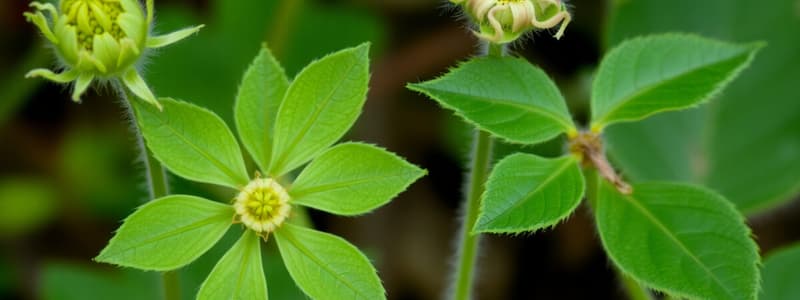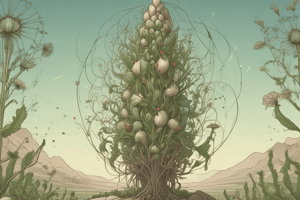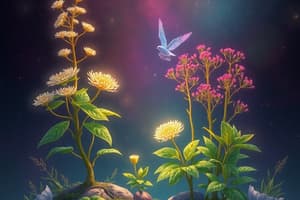Podcast
Questions and Answers
Which of the following is a key adaptation shared by all seed plants?
Which of the following is a key adaptation shared by all seed plants?
- Dominant gametophytes
- Extensive reliance on nonvascular tissues
- Water-dependent fertilization
- Heterospory (correct)
Which of the following describes the relationship between the sporophyte and gametophyte in seed plants?
Which of the following describes the relationship between the sporophyte and gametophyte in seed plants?
- The sporophyte is dominant, and the gametophyte develops within the sporophyte's tissues. (correct)
- The sporophyte is dependent on the gametophyte for nutrition.
- The gametophyte is dominant and independent of the sporophyte.
- Both sporophyte and gametophyte are equally dominant and independent.
Which of the following represents the correct order of structures found within an ovule of a seed plant?
Which of the following represents the correct order of structures found within an ovule of a seed plant?
- Megasporangium, integument, megaspore
- Megaspore, megasporangium, integument
- Integument, megasporangium, megaspore (correct)
- Megaspore, integument, megasporangium
Which of the following is the primary evolutionary advantage provided by seeds, compared to spores?
Which of the following is the primary evolutionary advantage provided by seeds, compared to spores?
Gymnosperms are characterized by:
Gymnosperms are characterized by:
Which of the following gymnosperm phyla contains the most species?
Which of the following gymnosperm phyla contains the most species?
Which of the following can be found in northern latitudes?
Which of the following can be found in northern latitudes?
What is the primary role of fruits in angiosperms?
What is the primary role of fruits in angiosperms?
Which of the following events is unique to angiosperm fertilization?
Which of the following events is unique to angiosperm fertilization?
How does habitat destruction primarily threaten plant diversity?
How does habitat destruction primarily threaten plant diversity?
Flashcards
What is a seed?
What is a seed?
A structure containing an embryo and nutrients, surrounded by a protective coat.
What are Gymnosperms?
What are Gymnosperms?
Plants with "naked" seeds, typically borne on cones. Includes cycads, ginkgos, gnetophytes, and conifers.
What are Angiosperms?
What are Angiosperms?
Seed plants with reproductive structures called flowers and fruits.
What is a Flower?
What is a Flower?
Signup and view all the flashcards
What is Fruit?
What is Fruit?
Signup and view all the flashcards
What is double fertilization?
What is double fertilization?
Signup and view all the flashcards
What is Endosperm?
What is Endosperm?
Signup and view all the flashcards
What are Monocots?
What are Monocots?
Signup and view all the flashcards
What are Eudicots?
What are Eudicots?
Signup and view all the flashcards
What is an Ovule?
What is an Ovule?
Signup and view all the flashcards
Study Notes
- Seeds changed plant evolution, allowing seed plants to dominate terrestrial ecosystems.
- A seed consists of an embryo and nutrients protected by a coat.
- Seed plant gametophytes develop in the walls of spores within parental sporophyte tissue.
- Reduced gametophytes, heterospory, ovules, and pollen are common to all seed plants.
Heterospory
- Megasporangia produce megaspores that yield female gametophytes.
- MIcrosporangia produce microspores that yield male gametophytes
Ovules
- An ovule contains a megasporangium, megaspore, and protective integuments.
- A fertilized ovule develops into a seed.
Evolutionary Advantages of Seeds
- A seed develops from the whole ovule.
- Seeds consist of a sporophyte embryo, food supply, and a protective coat.
- Seeds can remain dormant for extended periods until conditions favor germination.
- Seeds can be transported long distances via wind or animals.
Gymnosperms
- Gymnosperms bear "naked" seeds exposed on modified leaves or cones, not enclosed by ovaries
- The four gymnosperm phyla are:
- Cycadophyta (cycads)
- Ginkgophyta (Ginkgo biloba, one living species)
- Gnetophyta (Gnetum, Ephedra, Welwitschia)
- Coniferophyta (conifers)
- Seed plants are divided into gymnosperms and angiosperms.
- Gymnosperms appeared early in fossil records and dominated the Mesozoic terrestrial ecosystem
- Gymnosperms are better suited to drier conditions compared to nonvascular plants.
- Cone-bearing gymnosperms called conifers dominate the northern latitudes today.
- Ginkgo biloba tolerates air pollution and is a popular ornamental tree.
- Coniferophyta makes up the largest gymnosperm phylum.
- Most conifers are evergreen, photosynthesizing year-round.
Angiosperms
- Angiosperms are seed plants with reproductive structures called flowers and fruits.
- Angiosperms are the most diverse and widespread of all plants and classified under a single phylum: Anthophyta
- A flower is a specialized shoot for sexual reproduction with modified leaves and includes Sepals, Petals, Stamens, and Carpels
- A carpel consists of an ovary which contains ovules and a style which holds up a stigma, where pollen is received
- A fruit consists of a mature ovary, which can include flower parts.
- Fruits protect seeds and aid in seed dispersal, and can be fleshy or dry.
- Fruit adaptations aid in seed dispersal by wind, water, or animals.
- Male gametophytes are pollen grain and are produced by the microsporangia of anthers
- Female gametophyte (embryo sac) develops within an ovule contained in an ovary at the base of the stigma
- Most flowers use cross-pollination between different plants of the same species.
- A pollen grain that lands on a stigma germinates, and the pollen tube grows down to the ovary.
- Sperm enters the ovule through the micropyle pore.
- Double fertilization occurs when the pollen tube releases two sperm into the female gametophyte within an ovule.
- One sperm fertilizes the egg, forming a zygote.
- The other sperm combines with two nuclei, initiating the development of food-storing endosperm, which nourishes the developing embryo.
- Within a seed, the embryo consists of a root and cotyledons.
- Angiosperm and gymnosperm ancestors diverged about 305 million years ago.
- Angiosperms may be related to Bennettitales, which are extinct seed plants with flowerlike structures
- Amborella and water lilies are descendants of ancient angiosperm lineages.
- The two main angiosperm groups include monocots (one cotyledon) and eudicots (two cotyledons).
- Over one-quarter of angiosperm species are monocots, and over two-thirds are eudicots.
- Pollination of flowers and seed transport by animals is an important relationship in terrestrial ecosystems.
- Clades with bilaterally symmetrical flowers tend to have more species than those with radially symmetrical flowers.
- Bilateral symmetry impacts pollinator movement, reduces gene flow
Humans Need for Seed Plants
- Seed plants are important for human survival.
- Plants are sources of food, fuel, wood products, and medicine.
- Angiosperms provide most of human food; just six crops account for 80% of consumed calories
- Modern crops are products of recent genetic change through artificial selection.
- Seed plants provide secondary compound for wood and medicines.
- Habitat destruction is causing extinction of many plant species.
- Loss of plant habitat is also causing loss of animals which rely on the plants for support.
- If habitat loss continues at current rates, 50% of Earth's species will become extinct within 100-200 years.
Studying That Suits You
Use AI to generate personalized quizzes and flashcards to suit your learning preferences.




